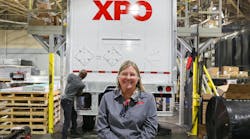We’re heading south on I-5 into the teeth of a blizzard. Although the snow isn’t sticking to the road, it’s cutting visibility to about a car’s length, so we exited the highway and turned back to the north on local roads under gray but clearing skies.
At the wheel of our white Kenworth T660 72-in. AeroCab tractor, powered by a 450-hp. Cummins ISX engine, is Matt Carrigg. A veteran test driver for Paccar, Carrigg also supervises all 13 of the company’s full-time test drivers, 11 of whom do double-duty as technicians at Paccar’s Technical Center here in Skagit County, WA. His team is responsible for testing all Kenworth and Peterbilt trucks.
“Our job is to try and make trucks as perfect as we can,” explained Carrigg. “We try to be that 98th percentile very observant drive r – the one who’s going to notice all the little squeaks and odd noises. We leave no detail, no matter how small, unchecked.”
Skagit County is the perfect place for test drivers in a lot of ways, with plenty of highways plunked down right alongside narrow roads winding through steep hills that then bottom out into acre upon acre of flat farmland. Everything from wheat, potatoes, corn, broccoli and tulips to wine grapes are grown right alongside the massive lumber mills and aerospace engineering facilities that dot an area bordered by the Cascade Mountains to the east and the calm, cold waters of Puget Sound to the west.
As we chug past old Victorian-style homes and farms tucked into tiny towns with names like Bow, Edison, Fir, and Conway, Carrigg lays out the critical skills necessary to make someone a good test driver.
“First, they must be mechanically inclined; they must have the ability to hear a noise and trace it back to a part or component,” he told FleetOwner. “They also must be open-minded about the fit, finish and feel of a truck. They can’t make assumptions based on sight alone.”
The most important part of a test driver’s protocol, however, is documentation. “They need to vigorously yet clearly and constructively convey in writing their experience with a particular truck, so engineers and lay people alike can understand where changes need to be made, and why,” he said. “That’s how you really make sure you come up with a finished product that’s durable and ergonomically friendly to the driver.”
Good test drivers are also multi-dimensional, Carrigg added – people who tinker in their off hours across a wide array of interests. For example, Carrigg points to the boating enthusiast, self-taught gunsmith, and rock and roll drummer within his test driver ranks. Almost all of them work on trucks, motorcycles and cars in their spare time.
In his own huge garage, Carrigg’s restoring a 1988 W900 to be a show truck. He also built his 3,000 sq.-ft. house largely on his own, down to the travertine tile floors and marble countertops in the kitchen.
“In our line of work, you really need to feel a truck to help mold it into the best it can be,” he added as we changed over to a viper red Kenworth T800 extended cab heavy haul tractor, powered by a Cummins 600 hp ISX. This truck is equipped with a manual Eaton 18-speed, which Carrigg prefers as it gets him more in touch with a truck’s particular nuances.
“It’s all about personal ownership of the process for a test driver,” he explained. “It’s that human element working in conjunction with the machine that helps you make the product the best it can possibly be.”
To comment on this article, write to Sean Kilcarr at [email protected]




